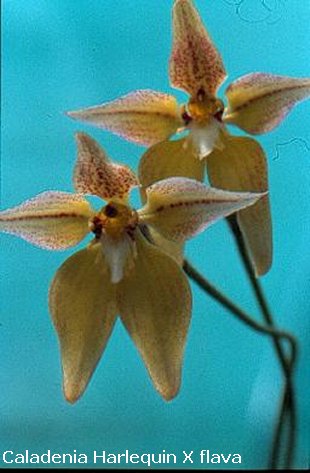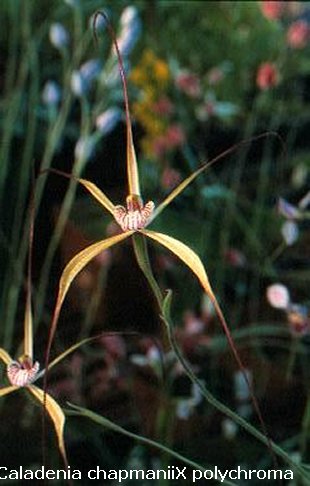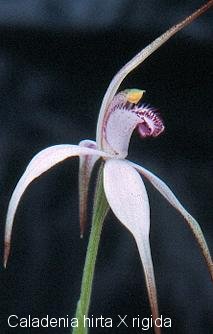|



Comments to
the offered plants:
Caladenia Harlequin
X Caladenia flava.
This hybrid has the
famous Caladenia Harlequin as motherplant, a natural hybrid occurring
in the Jarrah forests of south western Western
Australia. It was introduced into culture by Bob Bates
and later given to George Nieuvenhoven and others. Perfectly grown
by George, it won the Champion of the Show at the 3.
Australasian Orchid Conference in Adelaide, 1996. The
original plants were backcrossed to one of its parents, Caladenia
flava to give very beautiful progeny. Two strains were selected
as parents to give the second generation. One close
to Caladenia flava and one close to Caladenia Harlequin. Frost hardy
up to -3°C.
Caladenia chapmanii X polychroma.
Flowers, which need space. The
long filaments give flowers up to 200mm across.
|
Distribution:
Over 100 species, most are endemic to Australia. Some are found
in New Zealand and one extends to Indonesia, Malaysia and New Caledonia.
Description:
Flower stems 5 to 90cm high, with a single leaf. The periant
segments are often very long, giving the flower a spidery appearance.
Caladenia has a attractive glandular and hinged labellum, usually
decorated with calli. Many species are pollinated by sexual deceit,
attracting male thynnid wasps (spider orchids), other species pretend
to offer food (fairy orchids).
Culture:
Spider orchids are the touchstone of terrestrial orchid culture
and are not recommended for novice grower. As they have no or very
little roots, they are completely dependent on mycorrhizal fungi
for uptake of water and minerals. However, there are some species
and hybrids which are easier to grow. All plants are summer dormant
and rest as small tuberoids, that are protected by a touch, fibrous
tunic. Plants emerge in early or late autumn and flower in late
winter, spring or early summer. Culture sunny or lightly shaded.
Frost hardy up to -2°C. Regular watering during the growing period
is essential. Fertilize monthly with 0.1g/l until flowering. Reduce
watering with the onset of flowers and stop as the leaves die back.
Completely dry during dormancy. Occasionally a light spray of water
for small plants and seedlings to prevent dehydration. If grown
inside, move plants temporary outside in late summer as cool nights
and some rain will stimulate plants into the new growing season.
Repot every 2 or 3 years at the end of the dormancy.
Recommended potting mixes:
80% Seramis or fine to medium grade Perlite. 20% organic
components. Favourable are finely cut, fermented or N-impregnated
wood shavings or saw dust. (Toresa has given good results). No peat.
Spagnum moss is not suitable. Some extra wood on top of the pot.
Substrates have to be well draining with a pH of 5 to 6.
Further reading:
Cultivation of Australian native orchids produced
by the Australasian Native Orchid Society, Victorian group Inc.
Helen Richards, Rick Wootton, Rick Datodi.
Orchids of Western Australia produced by the Western Australian
Native Orchid Study and Conservation Group. Kingsley W.
Dixon, Bevan J Buirchell, Margret T. Collins
Native orchids of Australia. David Jones, 1993. Reed,
ISBN 0 7301 0189 4.
Orchids of south-west Australia. Noel Hoffmann and
Andrew Brown, 1992. University of Western Australia Press,
ISBN 1 875560 13 0.
The Orchids of Victoria. Gary Backhouse and Jeffrey Jeanes,
1996. Melbourne University Press, Carlton, Victoria. ISBN 584.1509945.
Field Guide to the Orchids of New South Wales and Victoria.
Tony Bishop, 2000. Second edition. University of New South Wales
Press. ISBN 0 86840 706 2.
|


